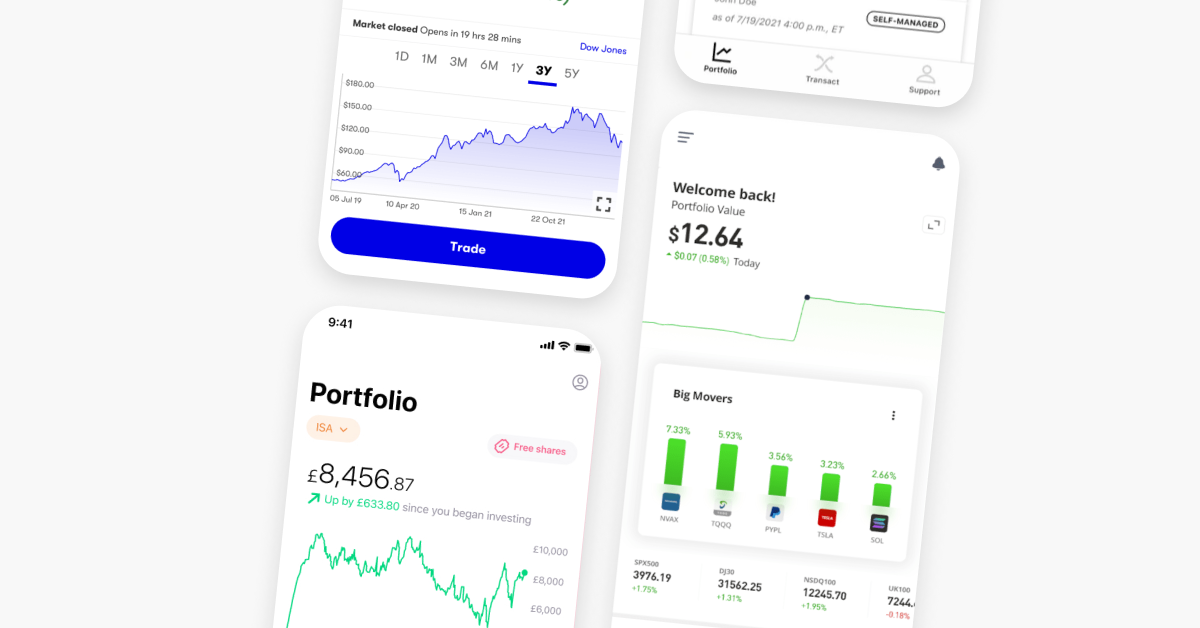Artificial intelligence (AI) is already having a huge impact on our lives, not least of which economically.
AI-powered companies are disrupting traditional industries and creating new markets, leading to a surge of investment as investors seek to get in on the ground floor of the next big tech revolution.
If you are considering investing in AI stocks, I recommend keeping a few things in mind. First, AI is a broad term that encompasses a wide range of technologies. Not all AI stocks are created equal.
Second, AI is a long-term investment. The full potential is still years away, so you should be prepared to hold your investments for the long haul. However, if you are patient, the rewards could be significant.
- What are AI stocks?
- Is AI advancing too fast, and why does it matter?
- 10 of the Best Performing Ai Stocks to Invest in 2023
- The Top AI Stocks in Detail
- What are the Best AI Stocks to Watch for the Long Term?
- What are the Best AI Stocks with Dividends?
- Factors to Consider When Investing in AI Stocks
- What are the Risks of AI Stocks?
- How to invest in AI stocks

What are AI stocks?
AI stocks refer to shares in companies that are involved in the research, development, and application of artificial intelligence (AI) technology.
These companies might be involved in any aspect of AI, including machine learning, deep learning, natural language processing, robotics, computer vision, and more.
Some of the major industries that I see benefiting from early growth in this area include:
- Tech giants: Large technology companies like Alphabet (Google’s parent company), Microsoft, and Amazon have significant AI operations and are already pioneering the use of AI to enhance their existing products and services. For example, Amazon uses AI to power its Alexa voice assistant, Microsoft uses AI to power its Azure cloud computing platform, and Alphabet uses AI to power its Google Search engine.
- Semiconductor companies: Companies such as Nvidia and AMD manufacture the chips and processors that power AI systems.
- Software and services: This could include firms that offer AI tools for businesses, such as Salesforce, or companies that use AI to deliver their services, like Netflix, for recommendations. For example, Salesforce offers an AI-powered customer relationship management (CRM) platform that helps businesses better understand and serve their customers.
- Robotics and automation: Companies in this category produce robots or automated systems that incorporate AI. These companies are developing AI-powered robots that can perform a variety of tasks, such as operating machinery, delivering packages, and providing customer service. For example, Boston Dynamics is a company that develops and sells humanoid robots that AI powers.
- Healthcare: Many biotechnology and healthcare firms are leveraging AI to enhance drug discovery, diagnostics, patient care, and more. For example, IBM Watson Health is an AI-powered platform that helps doctors to diagnose and treat diseases.
Investing in AI stocks can be a good way to get exposure to the growth of the AI market.
However, don’t overlook the risks involved in investing in AI stocks. These include the volatility of the AI market, the potential for AI to be used for malicious purposes, and the current regulatory uncertainty surrounding AI. We don’t know how much of this is going to unfold.
Is AI advancing too fast, and why does it matter?
With AI now available to perform tasks that were once considered unfeasible for machines, such as autonomous driving and generating news articles, a wide debate has sprung up about the speed of the technology’s advancement. As Fei-Fei Li, a computer scientist at Stanford University, states, “The pace of AI development is breathtaking. We’re moving at an exponential rate, and it’s hard to keep up.”
Another compelling reason is the interconnected nature of AI systems, which allows them to exchange data and learn from each other. This factor could accelerate AI’s development further, expanding its capabilities at a pace that may outstrip our capacity to regulate or understand it fully.
Many experts point out that AI growth could potentially result in powerful systems that pose an existential risk to humanity. Others fear AI could be employed for malicious purposes, such as the propagation of misinformation or digital propaganda, which could disrupt social harmony and democracy.
Arguments for accelerated development
On the other side of the argument, proponents of rapid AI development point towards its transformative potential.
AI could help address some of the most pressing global challenges, from climate change to poverty eradication.
Noted physicist and author, Stephen Hawking, aptly summarized the dual potential of AI, stating, “AI has the potential to do great good, but it also has the potential to do great harm. We need to be thoughtful about how we develop and use this technology.”
10 of the Best Performing Ai Stocks to Invest in 2023
Here are the ten best-performing stocks in the Indxx Global Robotics & Artificial Intelligence Thematic Index, ordered by one-year returns:
The Indxx Global Robotics & Artificial Intelligence Thematic Index is a stock market index that tracks the performance of companies that are involved in the robotics and artificial intelligence (AI) industries.
| Rank | Company | One-Year Return (%) |
|---|---|---|
| 1 | Symbotic Inc. | 182.26% |
| 2 | Helix Energy Solutions Group, Inc. | 153.93% |
| 3 | C3.ai, Inc. | 140.94% |
| 4 | Intuitive Surgical, Inc. | 132.58% |
| 5 | SoundHound AI, Inc. | 124.83% |
| 6 | AeroVironment, Inc. | 122.73% |
| 7 | ABB Ltd. | 118.39% |
| 8 | Keyence Corp. | 117.41% |
| 9 | Fanuc Corp. | 115.68% |
| 10 | Nvidia Corp. | 114.84% |
The Top AI Stocks in Detail
Symbiotic Inc
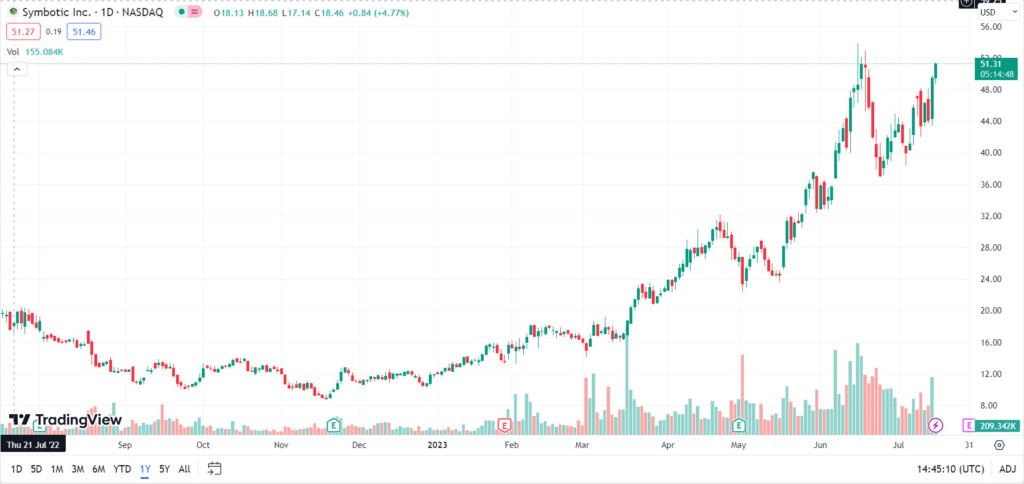
- Symbiotic Inc has developed an AI-powered software system that acts as the “conductor” to coordinate a fleet of autonomous robots in warehouse operations. Essentially, their AI software optimizes the movement and storage of inventory by the robots.
- Autonomous robots, called “Symbots”, use AI and computer vision for tasks like product retrieval and robotic picking. They can move at high speeds of 25 mph with extreme precision due to the AI.
- The AI software manages the Symbots to achieve greater efficiency, less product damage, and faster speed in fulfilling customer orders.
- Symbiotic has over 250 issued patents related to its AI and robotics supply chain platform. This suggests they are actively innovating in this space.
- They are applying the technology beyond just retail into new industries like auto parts, apparel, and home improvement. Expanding the AI platform to new use cases.
Helix Energy Solutions Group, Inc.
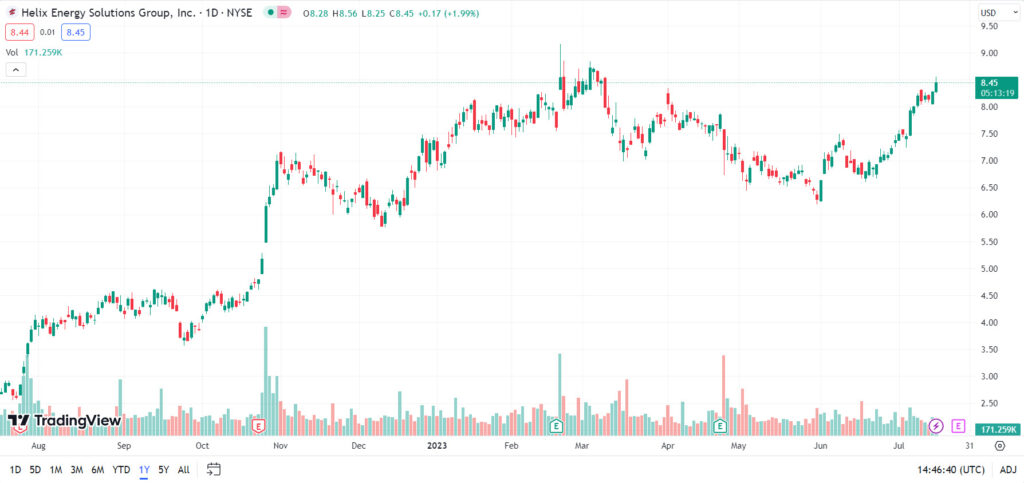
Helix Energy Group is in Global Robotics & Artificial Intelligence Thematic Index because of its pioneering use of robotics in the oil and gas industry. Here’s what sets them apart:
- Helix has a dedicated Robotics segment that provides services like seabed trenching, inspection, repair and maintenance to the offshore energy industry using remotely operated vehicles (ROVs) and robotic tools.
- Their robotics services support operations like subsea well intervention, offshore wind farm construction, burying power cables, and clearing debris at offshore sites. Expanding the applications of robotics.
- They use robotics in both oil/gas and renewable energy markets. Adapting robotics technology to the energy transition.
- They have robotics support vessels on term charters to flexibly deploy the robotic tools and ROVs. Investing in the logistics/deployment side.
- The company focuses on using robotics for tasks like inspection, repair, and seabed preparation that are hazardous, costly or inefficient for human divers. Removing humans from harm’s way.
In summary, Helix seems to be at the forefront of leveraging robotics and automation to perform key offshore energy operations safely, efficiently and across energy sectors. Their scale of investment in a dedicated robotics fleet and services suggests they are pioneering the adoption of robotics in the oil and gas industry.
C3.ai
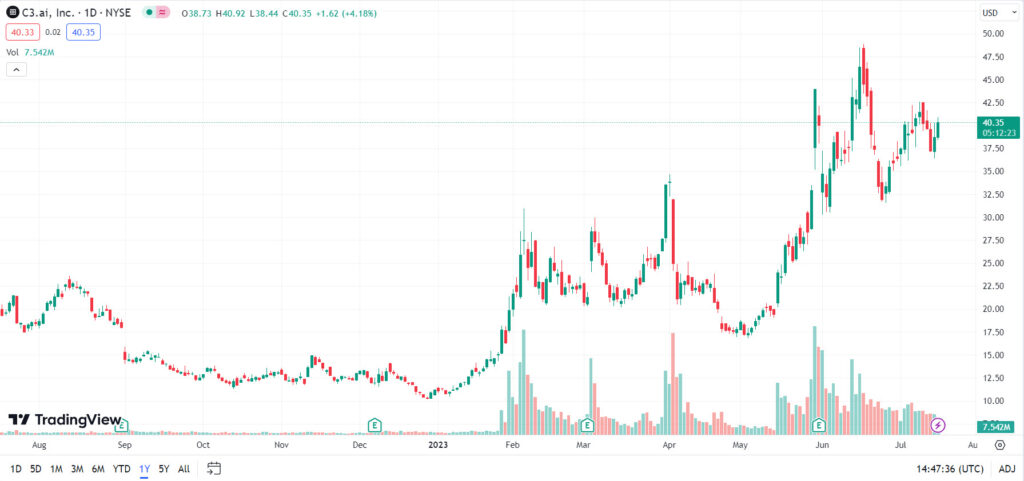
C3 AI is a software company that provides platforms and applications to enable organizations to rapidly build, deploy, and scale enterprise AI.
- Their core C3 AI Application Platform is an end-to-end solution that allows developers to quickly design, develop and manage the entire lifecycle of AI applications using model-driven architecture.
- In addition, they offer a growing portfolio of prebuilt, configurable AI applications for common use cases like predictive maintenance, anti-money laundering, customer churn prediction etc. These industry-specific applications allow organizations in manufacturing, financial services, healthcare and other sectors to start realizing business value from AI in months rather than years.
- The applications all run on the integrated C3 AI platform, enabling data governance, model management, and deployment scaling across the enterprise AI ecosystem. The platform supports all major cloud infrastructures like AWS, Azure and Google Cloud for flexible deployment.
Intuitive Surgical
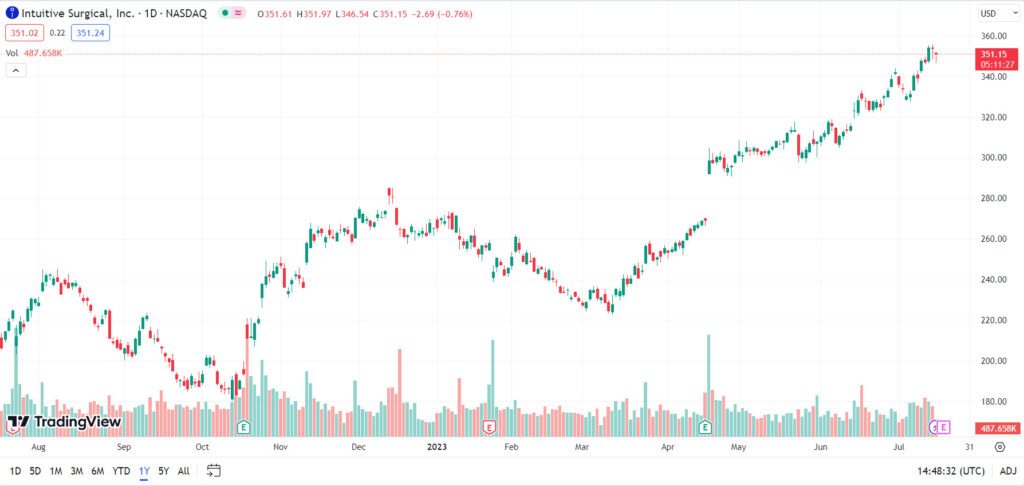
Intuitive Surgical is the company behind the da Vinci surgical system, which enables robotic-assisted minimally invasive surgery. It allows surgeons to perform complex procedures through tiny incisions using robotic arms equipped with miniaturized instruments.
- The Da Vinci provides surgeons with enhanced visualization of the surgical site in 3D and high definition. This immersive view with depth perception helps surgeons better identify anatomical structures. The system also filters out hand tremors and enables precise movements of the robotic instruments.
- Intuitive Surgical has integrated advanced technologies like near-infrared fluorescence imaging, allowing surgeons to visualize anatomical structures like vessels and tissue perfusion during surgery. This extends human vision capabilities.
- The company is also developing intelligent surgical tools like staplers that use real-time sensory data and automation to help ensure optimal performance and prevent complications. This showcases robotic augmentation of surgical skills.
- Intuitive is exploring the use of data from past da Vinci surgeries and AI-based insights to improve surgical training and education. This could help increase access to and standardization of robotic surgery globally.
Soundhound AI
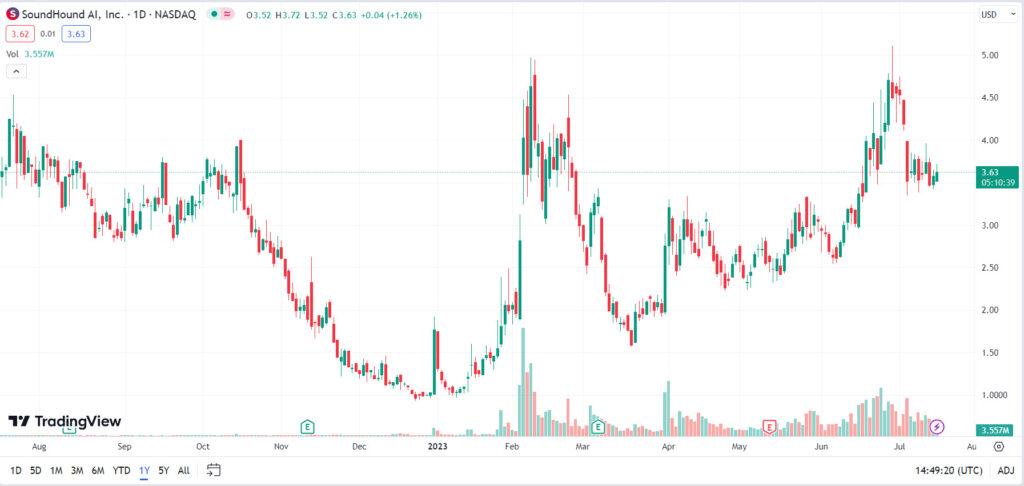
SoundHound is an artificial intelligence company focused on voice recognition and conversational AI. Their core technology is Speech-to-Meaning and Deep Meaning Understanding, allowing speech recognition with deep language comprehension.
- SoundHound has launched SoundHound Chat AI, a conversational AI platform that enables businesses to build voice assistants. It combines SoundHound’s proprietary voice AI with third-party generative AI like ChatGPT.
- The platform keeps conversations going by intelligently selecting responses from different domains – generative AI, real-time data, or SoundHound’s own knowledge models. This avoids incorrect or hallucinated responses.
- SoundHound uses its own software engineering approach called CaiLAN to build knowledge domains efficiently. It uses machine learning called CaiNet to understand queries better and select the right responses.
- This combination of software engineering and ML ensures faster, more accurate responses compared to relying solely on generative AI.
- The platform provides voice access to generative AI, allowing natural conversational interactions rather than awkward search queries. Users can ask questions, give commands, get recommendations and clarify interactively.
- SoundHound already powers voice assistants for companies in automotive, smart devices, restaurants and other sectors. The SoundHound Chat AI platform now makes generative AI accessible via voice for businesses.
AeroVironment Inc
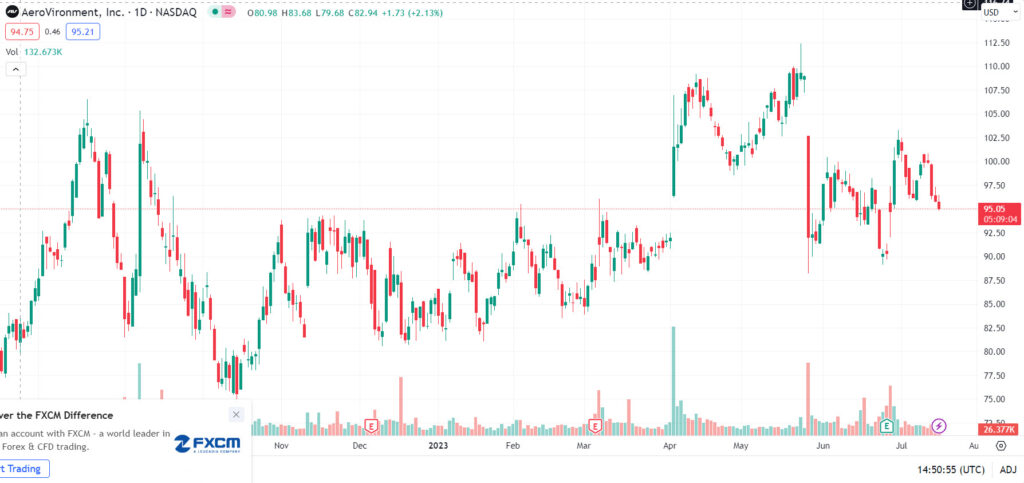
AeroVironment is focused on developing unmanned aircraft systems (UAS), unmanned ground vehicles (UGV), and related technologies for defence and commercial applications. Their unmanned systems integrate sensors, automation, robotics and AI to deliver enhanced information gathering, target acquisition and other tactical capabilities to soldiers, first responders and commercial users.
- They have designed over 30 types of small, lightweight UAS like the hand-launched Raven and Puma AE for reconnaissance and surveillance.
- Their Switchblade loitering missile systems are mini kamikaze drones that can lock onto targets before precision striking them. They provide lethal strike capabilities with minimized collateral damage.
- AeroVironment’s unmanned ground vehicles like the Telerob EOD are used for tasks like explosive ordnance disposal. They remove humans from dangerous situations.
- The company has developed high-altitude solar-powered UAS that provide persistent surveillance and communication capabilities like a satellite, but at lower cost.
- AeroVironment also built the Mars Helicopter Ingenuity that made the first powered flights on another planet, pushing robotic flight’s capabilities.
ABB Group
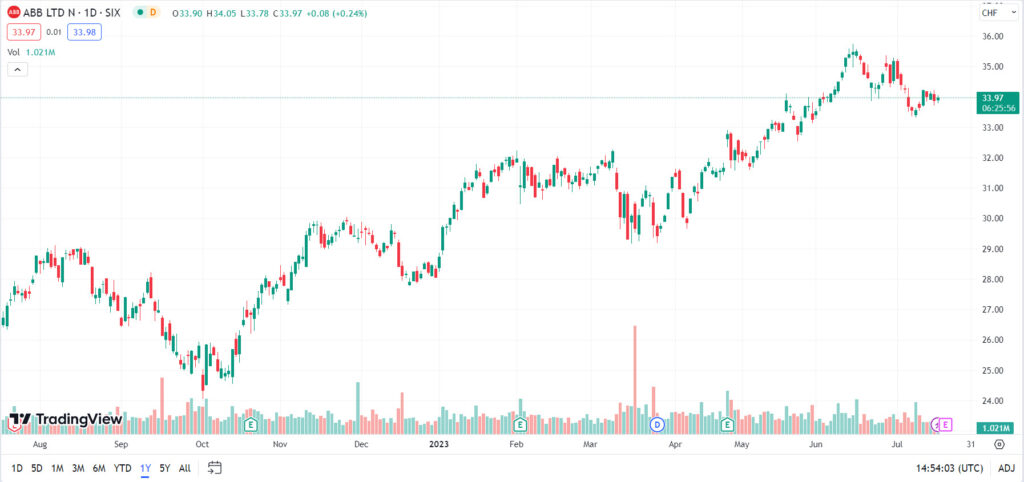
ABB is a technology company focused on electrification, automation, robotics and motion. They are integrating AI into many of their offerings.
- ABB’s Industrial AI Accelerator program partners with AI startups to quicken the development of industrial AI solutions. This allows ABB to gain capabilities rapidly.
- They use technologies like machine learning and computer vision to improve monitoring, predictive maintenance, quality control and other processes for industry customers.
- ABB has developed AI solutions for needs like forecasting renewable energy generation, optimizing employee skills matching, and predictive maintenance.
- Their AI research has created robotics innovations like their PixelPaint system, which uses a robotic arm with a clever AI algorithm to paint any picture uploaded by a user.
- ABB also does pioneering work on digital twins – virtual models of physical systems – enabled by AI, automation and IoT to optimize performance.
- ABB co-bots incorporate AI safety features to collaborate smoothly with human workers. They have deployed over 14,000 co-bots worldwide.
Keyence Corp
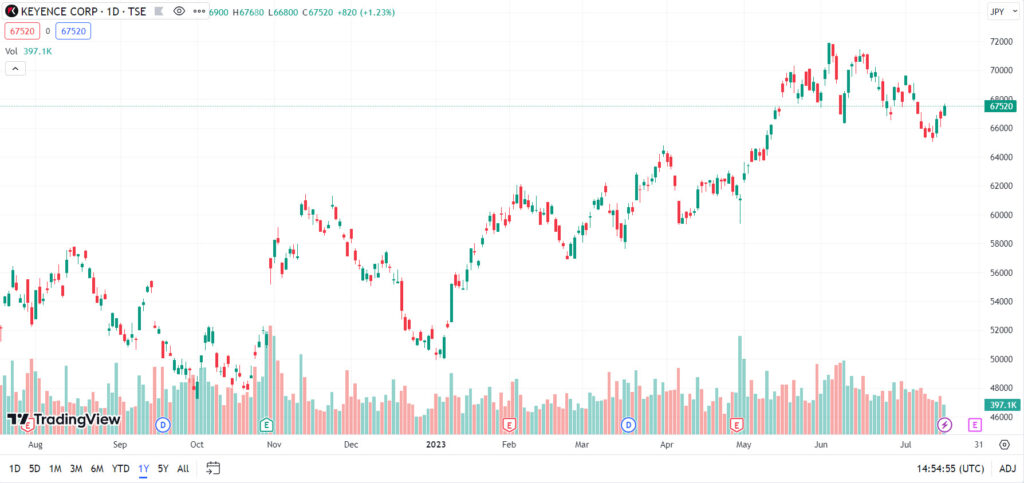
Keyence Corp is a major Japanese company that develops and manufactures automation sensors, barcode readers, vision systems, laser markers and other equipment for factory automation.
- Keyence uses AI and deep learning in its machine vision systems to enable automated inspection, quality control, robotic guidance and other industrial applications. For example, its vision sensors can detect defects and anomalies on production lines.
- The company offers robot vision systems that provide the camera sensors and AI-powered image processing algorithms to guide robotic operations like picking and assembly. This eliminates the need for manual programming of robots.
- Keyence is also applying AI to fields like microscopic imaging to automatically detect anomalies or diseases from specimen images.
- The company pioneered innovative static electricity elimination technology early on and has over 14,000 patents today, reflecting its focus on research and innovation.
Fanuc Corp
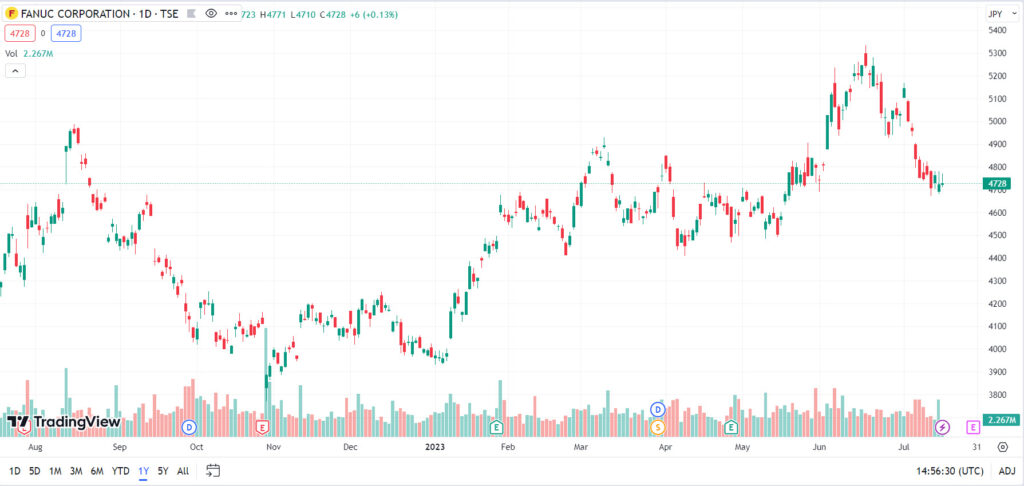
Fanuc is one of the world’s largest industrial robotics companies, supplying robotics systems for factory automation globally.
- The company has developed an open Industrial IoT platform called FIELD that connects machines, robots, sensors etc within a factory to collect and analyze data. This allows deriving insights through AI to optimize production.
- Specific applications include LINKi for monitoring devices and getting alerts, and ZDT which uses predictive analytics to detect potential equipment failures and recommend maintenance.
- For robotics, Fanuc is applying machine learning and AI to enable features like more intuitive programming by demonstration. This reduces the need for complex coding to train robots.
- They are also developing capabilities like automated error detection and correction when robots are performing tasks like bin picking. This improves the robots’ ability to handle variability.
Nvidia Corp
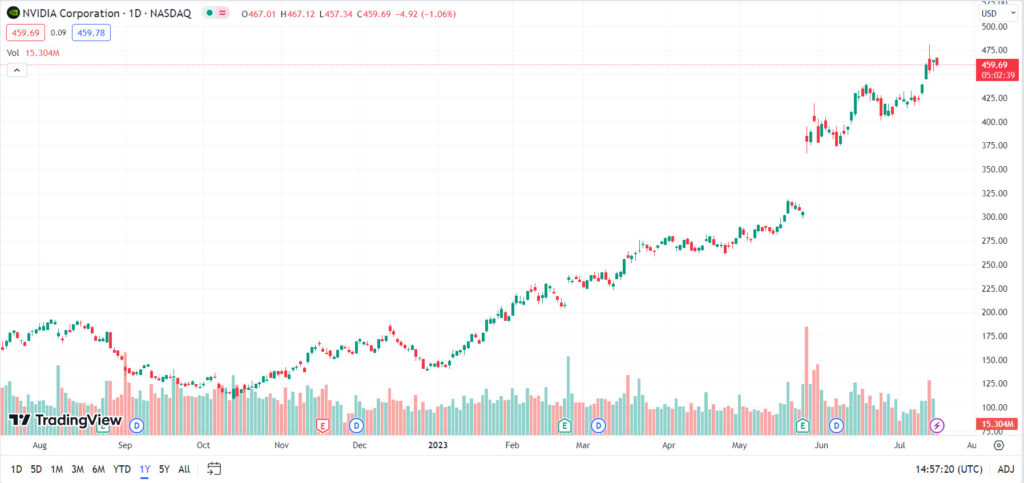
Nvidia is a leading technology company that originally pioneered graphics processing units (GPUs) for gaming and computer graphics. However, Nvidia GPUs turned out to be ideally suited for running deep learning algorithms due to their parallel processing capabilities.
- In the late 2000s, Nvidia pivoted to make AI a core focus of its business. It developed software libraries, frameworks and end-to-end systems like DGX to optimize its GPUs for AI workloads like training deep neural networks.
- Nvidia dominates the GPU market with an over 80% market share. Its GPUs power leading AI research labs and companies. AI models like ChatGPT require thousands of GPUs to train. This results in huge demand for Nvidia chips.
- The company continues to innovate with new GPU architectures like Hopper that integrate advances to accelerate transformer-based AI models used in generative AI. Nvidia also provides full-stack AI software tailored to industries.
- With AI poised to transform every sector and industry, Nvidia is uniquely positioned to benefit as a pick-and-shovel provider of the AI training and deployment infrastructure. Its platforms and ecosystem fuel AI innovation across the board.
- Nvidia’s first-mover advantage, specialized AI chips and software give it a competitive edge difficult for rivals to match. The AI revolution will drive enormous growth for Nvidia’s data centre business in the coming years.
What are the Best AI Stocks to Watch for the Long Term?
- Amazon (AMZN) – Amazon has invested heavily in AI for its retail business, cloud computing services, and Alexa virtual assistant. As a leader in cloud infrastructure, Amazon is poised to benefit as more companies adopt AI.
- IBM (IBM) – IBM has reinvented itself to focus on AI and cloud services. It offers the Watson platform for developing enterprise AI applications. IBM’s expertise positions it well for long-term growth.
- Baidu (BIDU) – Often referred to as the “Google of China,” Baidu has invested significantly in AI research. It offers a suite of AI tools and services and is a leader in autonomous driving technology.
- Qualcomm (QCOM) – Qualcomm produces advanced semiconductor chips used in smartphones and other devices. Its chips help power AI applications on devices. It stands to gain as on-device AI becomes more common.
- Intel (INTC) – Intel manufactures advanced processors needed to handle computationally intensive AI tasks. It also offers software tools like OneAPI to streamline AI development. Intel will remain relevant as AI chip demands increase.
The key for long-term investing is to focus on established tech companies with proven track records in AI research and commercialization. These companies are poised to benefit from the long-term trend towards AI adoption across industries.
What are the Best AI Stocks with Dividends?
- Nvidia (NVDA)
As a foremost designer of graphics processing units (GPUs), Nvidia provides the core chips that enable many artificial intelligence systems to function. Revenue from Nvidia’s data center segment, which encompasses AI, recently expanded by over half in the company’s most recent fiscal quarter.
While Nvidia’s dividend yield is on the lower side at roughly 0.1%, the payout has compounded at an annualized rate of 20% over the past 5 years. With robust cash flows and a 31% payout ratio, Nvidia appears to have ample capacity to prolong dividend expansion.
- IBM (IBM)
IBM was an early AI trailblazer, having pioneered the technology with its Watson system. The company persists in pushing AI advancement, recently integrating Watson capabilities into its mainframe solutions. IBM has boosted its dividend annually for 28 straight years, granting it membership in the Dividend Aristocrats.
IBM provides an engaging income stream with a dividend yield above 5% and a reasonable 64% payout ratio. However, its turnaround continues to be a work in progress.
- Texas Instruments (TXN)
Texas Instruments manufactures analog and embedded chips that enable electronics functionality across industries. It is now leveraging its chip design expertise to enable AI applications like smart home devices.
Texas Instruments has expanded its dividend annually for 19 consecutive years and currently yields over 3%. The company appears poised to perpetuate dividend growth with a robust balance sheet and 79% of revenue stemming from analogue and embedded.
Factors to Consider When Investing in AI Stocks
- Financial performance: Look at the company’s financial statements to see how it has been performing financially. Look for signs of growth, such as increasing revenue and profits.
- Competitive landscape: Analyze the company’s competitive landscape to see how it compares to its competitors. Look for companies that have a strong market position and a competitive advantage.
- Future growth potential: Consider the company’s future growth potential. Look for companies that are well-positioned to capitalize on the growth of the AI market.
- Management team: Evaluate the company’s management team. Look for a team with a proven track record of success in the AI industry.
- Risk of regulation: Consider the risk of regulation. The AI industry is still in its early stages, and there is a risk that it could be regulated in the future.
- The volatility of the AI market: The AI market is still volatile, so be prepared for the possibility of sharp price swings.
- Company’s focus: Some AI companies focus on a specific application of AI, such as facial recognition or natural language processing. Others have a broader focus and are developing AI-powered solutions for a variety of industries.
- Company’s technology: Some AI companies have proprietary technology that gives them a competitive advantage. Others rely on open-source technology, which can make it more difficult to differentiate themselves from their competitors.
- Company culture: AI companies tend to be more innovative and entrepreneurial than traditional companies. Look for companies with a culture that encourages risk-taking and innovation.
What are the Risks of AI Stocks?
Investing in AI stocks comes with a variety of risks that potential investors need to consider.
One of the significant risks is potential future regulation. As the AI industry is still nascent, governments may enforce stringent rules that could impact the profitability of AI companies.
Secondly, many AI companies, still in their developmental stages, haven’t yet established a clear path to profitability.
It’s also worth pointing out that the AI market is characterized by its high volatility, meaning investors should brace for sharp price fluctuations, which could complicate the timing of investments and the realization of profits.
Additionally, AI systems are susceptible to bias, as they are trained on data sets that may inherently be biased. The resulting biased AI systems could trigger discriminatory practices, leading to broader societal and reputational repercussions.
Lastly, as AI continues to evolve, there is an increasing risk of job displacement in certain sectors. This factor could, in turn, impact public sentiment towards AI and, consequently, the demand for AI stocks.
How to invest in AI stocks
- Open a brokerage account. This is an account that allows you to buy and sell stocks. There are a number of different brokerage accounts available, so it is important to choose one that is right for you.
- Do your research and understand the company and the industry. This includes looking at the company’s financial performance, competitive landscape, and future growth potential.
- Consider the risks, including the risk that some companies may not be successful and the risk of regulation.
- Choose the right stocks for your investment portfolio, considering your risk tolerance and investment goals.
- Invest for the long term. AI is a long-term investment, so it is important to be patient and invest for the long term. The AI industry is still developing, and there is potential for significant growth in the future.
- Diversify your portfolio by investing in a variety of AI stocks. This will help to reduce your risk if one company fails.
- Rebalance your portfolio regularly as your investment goals change.
- Monitor your investments regularly to make sure they are still on track. This includes checking the performance of your stocks and the overall AI industry.

